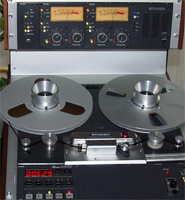THIS ERO (Roederstein) CAPACITOR IS A "PULL" - REMOVED/TESTED
Ex obsolete (no longer has a useful purpose) German test equipment
ERO
So who is/was ERO? The company behind the market brand was Roederstein, they started manufacturing capacitors way back in 1925 and were based in Berlin. In the early 1990's, Roederstein was acquired by Vishay - no more ERO but their product range lives on and even today you can purchase "modern" versions in the 790D series from Vishay
Older capacitors, used capacitors are much maligned, especially amongst those who have no technical knowledge but instead gather their opinions from others online who also have no idea! Lemmings
A favourite past-time for some folks is to bash "old stuff" with no valid reasoning, just "it's old it must be rubbish" - ignorance abounds on the subject of capacitors especially.
My own view is that capacitors with KNOWN manufacturing processes and specifications are likely to be useful many years after they were manufactured or installed into equipment. It is important not to just focus on the capacitor but how it is being used, particularly in consumer equipment where the mighty dollar takes precedence over all else. An example of this is a standard electrolytic filter capacitor sitting across an unfiltered choppy 12V DC rectifier output. It would be safest to use a 25V or even 40V working electro here but instead many manufacturers reduce the capacitor to as low as 15~16V purely because the lower the voltage rating, the lower the cost of the capacitor used (smaller too) But that lower working voltage capacitor is "living on the edge" and trying to do it's best while being forced to work almost outside of the maximum's . Just a spike or two induced into the AC supply and the capacitors could easily be tipped "over the edge" and suffer damage.
It doesn't matter how "top quality u-beaut" the capacitor is, if it is fitted into a poorly designed circuit or where it is expected to be operated near it's maximum characteristics in order to save the equipment manufacturer some costs, it will give problems and possibly self destruct just like any other capacitor "good" or "bad"!
Not the capacitors fault, poor circuit design is the cause of the problem.
These solid tantalums from ERO are in the same boat, they are very reliable polarised capacitors WHEN USED IN A PROPERLY DESIGNED CIRCUIT. You won't see many of these in consumer equipment, they were (and still are) expensive which usually placed them well outside of a consumer product manufacturer's costings. However, often you will find these ERO TANTAL's in professional equipment, such as the test gear I have just finished operating on and my "God of 1/4" tape machines" the beautiful STUDER A810 reel to reel machine - approaching 50 years old and still going strong and it is loaded with these caps.

Phew ... with that spiel off my chest, here is my description of this capacitor and the test results
ERO (Roederstein) Germany Tantalum Capacitor
Type: Solid Tantalum
Circa 1980's - 1990's
Resin box PURPLISH/PINK
Radial package
Nominal value: 47uF
Maximum voltage: 16V DC
20% tolerance (assumed as I cannot see a tolerance code on the body)
Manufacturing print on the body is:
Topside
+47
+16V-
One side
ERO TANTAL (logo in a box)
H7 or J6 (assumed to be a batch code)
DIMENSIONS:
12mm length x 7.25mm wide x 9.85mm height
PCB "legs" have not been cut but are short at 4mm (just long enough for through-hole PCB use)
COSMETIC CONDITION:
USED
CLEAN
Legs are reasonably clean of solder, bright and shiny. I did see a capacitor with the remnants of a PCB copper "through hole" on the leg so perhaps a quick cleanup of the leg(s) might be in order
TESTING:
Tested EACH capacitor ...
MEASURED VALUE ESR
51.65uF 1.8 Ohm
52.68uF 2 Ohm
52.62uF 2.3 Ohm
All reading higher than the nominal value and actually these look to be 10% tolerance, not 20% as first thought
These solid tantalum capacitors are now packed in sealed clear plastic packets, ready to be put to work once again ...












